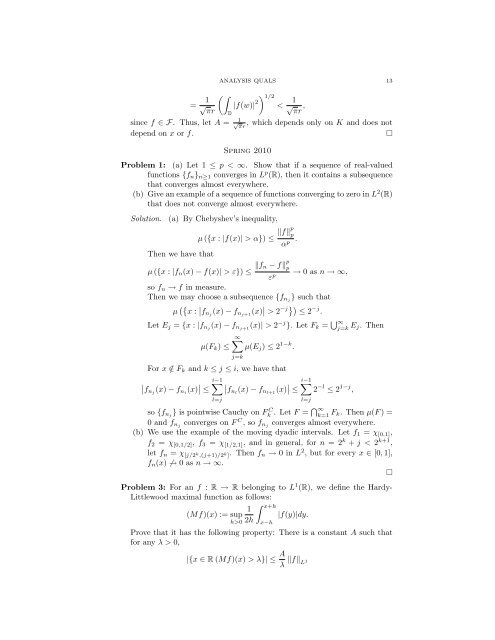ANALYSIS QUALIFYING EXAM PROBLEMS BRIAN LEARY ...
ANALYSIS QUALIFYING EXAM PROBLEMS BRIAN LEARY ...
ANALYSIS QUALIFYING EXAM PROBLEMS BRIAN LEARY ...
Create successful ePaper yourself
Turn your PDF publications into a flip-book with our unique Google optimized e-Paper software.
<strong>ANALYSIS</strong> QUALS 13<br />
= 1<br />
<br />
√ |f(w)|<br />
πr D<br />
2<br />
1/2 < 1<br />
√ ,<br />
πr<br />
since f ∈ F. Thus, let A = 1 √ , which depends only on K and does not<br />
πr<br />
depend on x or f. <br />
Spring 2010<br />
Problem 1: (a) Let 1 ≤ p < ∞. Show that if a sequence of real-valued<br />
functions {fn}n≥1 converges in L p (R), then it contains a subsequence<br />
that converges almost everywhere.<br />
(b) Give an example of a sequence of functions converging to zero in L 2 (R)<br />
that does not converge almost everywhere.<br />
Solution. (a) By Chebyshev’s inequality,<br />
µ ({x : |f(x)| > α}) ≤ fp p<br />
.<br />
αp Then we have that<br />
µ ({x : |fn(x) − f(x)| > ε}) ≤ fn − f p<br />
p<br />
εp → 0 as n → ∞,<br />
so fn → f in measure.<br />
Then we may choose a subsequence {fnj } such that<br />
µ x : fnj (x) − fnj+1 (x) > 2 −j ≤ 2 −j .<br />
Let Ej = {x : |fnj (x) − fnj+1 (x)| > 2−j }. Let Fk = ∞<br />
j=k Ej. Then<br />
µ(Fk) ≤<br />
∞<br />
µ(Ej) ≤ 2 1−k .<br />
j=k<br />
For x /∈ Fk and k ≤ j ≤ i, we have that<br />
<br />
fnj (x) − fni (x) ≤<br />
i−1<br />
<br />
fnl (x) − fnl+1 (x) i−1<br />
≤<br />
l=j<br />
l=j<br />
2 −l ≤ 2 1−j ,<br />
so {fnj } is pointwise Cauchy on F C k . Let F = ∞<br />
k=1 Fk. Then µ(F ) =<br />
0 and fnj converges on F C , so fnj<br />
converges almost everywhere.<br />
(b) We use the example of the moving dyadic intervals. Let f1 = χ [0,1],<br />
f2 = χ [0,1/2], f3 = χ [1/2,1], and in general, for n = 2 k + j < 2 k+1 ,<br />
let fn = χ [j/2 k ,(j+1)/2 k ]. Then fn → 0 in L 2 , but for every x ∈ [0, 1],<br />
fn(x) → 0 as n → ∞.<br />
<br />
Problem 3: For an f : R → R belonging to L1 (R), we define the Hardy-<br />
Littlewood maximal function as follows:<br />
1<br />
(Mf)(x) := sup<br />
h>0 2h<br />
x+h<br />
x−h<br />
|f(y)|dy.<br />
Prove that it has the following property: There is a constant A such that<br />
for any λ > 0,<br />
|{x ∈ R (Mf)(x) > λ}| ≤ A<br />
λ f L 1
















